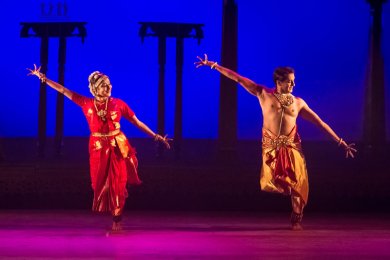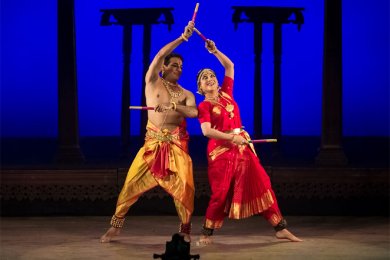
|   |

|   |
The golden era of the Wadiyars - G. Ulaganathan e-mail: ulag_nath@yahoo.com Photos: Narayanan Vinoba October 8, 2015 A brilliant musical dance tribute was paid to the Wadiyars of Mysore who ruled the former princely state of Mysore from the early 15th to the mid 20th century, at the Chowdiah Hall on September 26 by the well known dance duo, Lakshmi Gopalaswamy and Satyanarayana Raju. With clever use of Carnatic music and Bharatanatyam, the dance feature took the audience on a journey down the historical lane to the glorious period of the royal rule and showed how they patronised arts and culture.  The performance was called ‘Under the Double Eagle’ which was a little intriguing. Why English title for an indigenous production? Gandaberunda, which was the ensign of the Royal House of Mysore, is quite musical to the ears and would have been an apt title. Organised under seven Acts, the dance feature opens with the celebration of Dasara festival. On Vijayadasami, the last day of the festival, the goddess Chamundeshwari is brought in procession through the city. The king and the people of the city offer flowers and pray to the goddess for her protection and munificence. The composition of Mysore Vasudevacharya, one of Mysore’s best known composers, was used for this inaugural act in which both Satya and Lakshmi, with their excellent coordination, set the tone for the next six Acts. Act two begins with Yaduraya of Dwaraka (1371-1423) being told in a dream to visit the temple of Goddess Parvati at Mahabala Parvata between rivers Cauvery and Kapila near Mysore. The local king Chamaraja dies and there is a plot by his military commander Maranayaka to usurp the throne. On waking up, he finds a sword and with that he kills the commander and marries the king’s daughter. He becomes the Wadiyar, the first chieftain of thirty three districts and thereby founding the Wadiyar dynasty. This was the most dramatic episode and Satya endured himself as an able dancer and actor. In the next Act, Ranadeera Kanteerava Narasaraja Wadiyar came out as a man of extraordinary courage and valour - he vanquishes 25 mercenaries at one go in a physical combat and proves himself as an astute and far-sighted administrator. Mysore, under him, minted its own coin bearing Varaha seal, saw the construction of a dam across river Koundini, a school near Srirangapatna sprang up to teach dance, and became a great patron of arts. His palace was always open to musicians and scholars and resounded with the strains of veena music. Then Lakshmi Gopalasway performed brilliant swara jathis in true Mysore style of Bharatanatyam which flourished under the rule of Chikka Deavaraja Wadiyar (1645-1704). As a special tribute to him, the dancers presented a rare sloka ‘Ranga Devathe’ in raga Arabhi. Lakshmi stole the show with her neat expressions and footwork while rendering the complex jathis. Act 5 explains the mystery of Gandaberunda, the mythical bird whose two heads symbolise justice and vigilance. When one head sleeps, it is said, the other is awake. A traditional Paaraku or royal salutation to Mummadi Krishnaraja Wadiyar (1794-1868) was followed by a jawali in Athana ragam by Veene Padmanabaiah to highlight the ruler’s fondness for romantic-devotional compositions in Bharatanatyam repertoire.  The Golden Age of Mysore was the early 19th century (1902-40). After the coronation of Krishnaraja Wadiyar, Mysore developed as a hub of education, technology, along with liberal patronage of arts. Satya and Lakshmi movingly presented the episode in which the Wadiyar’s mother Maharani Vani Vilasa Sannidhana sells her personal jewellery so that her son’s dream project, the Krishnarajasagar Dam becomes a reality. Muthaiah Bhagavathar, who was patronised by the Wadiyar, was made the court composer and his daaru-varna, Maathe Malayadwaja in ragam Khamaj was used by the dance duo to illustrate Krishnaraja Wadiyar’s great contributions to various fields. No less was the contribution of the last Maharaja of the princely state, Jayachamaraja Wadiyar. He himself was a great composer and each one of 94 kritis he composed in Sanskrit is a masterpiece in structure, language and meaning. The final Act was a tribute to his musical genius and intellect, who left a memorable archive of material. The entire show was brilliantly choreographed and the accompanying artists wearing a Mysore turban and dressed in true court style was a visual treat. Another remarkable feature was the conclusion by the singing of the State Anthem of Mysore, Kayo Sri Gowri by Basavappa Shastri who composed it for the coronation on the 1st March 1881 of Chamaraja Wadiyar IX with instrument support by Veena Seshanna and the then palace bandmaster Bartels to notation in C -Major based on raga Dheera Shankarabharana. It is widely believed that this anthem was the real inspiration for Rabindranath Tagore to compose the National Anthem of India. ‘Under the Double Eagle’ was a unique tribute to the prestigious Wadiyar dynasty of Mysore. It was quite apt that two sisters of the late Wadiyar were there to witness the dance feature. They were truly overwhelmed and so were each one of the rasikas of Bengaluru in the jam packed auditorium. Raghuram’s soulful singing, Natarajamurthy’s violin, Ammannayya’s flute and Harsha Samaga’s mridangam support added value and enhanced the appeal of the whole programme. The show was part of the 40th anniversary concert series of the International Music and Arts Society in collaboration with The Bangalore International Arts Festival. G. Ulaganathan is a senior writer and journalist based in Bangalore. |